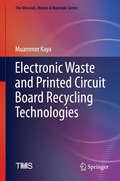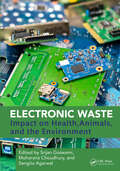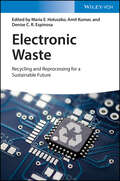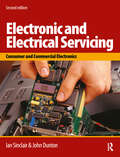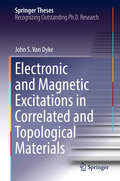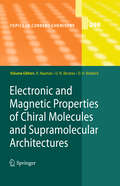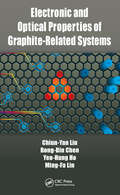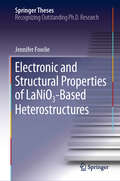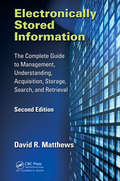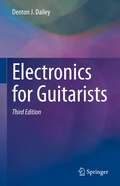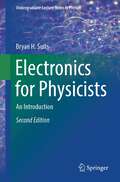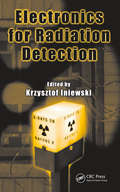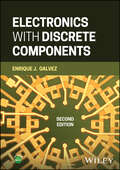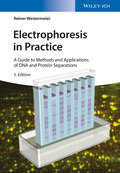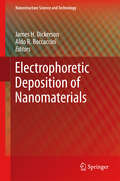- Table View
- List View
Electronic Transport Theories: From Weakly to Strongly Correlated Materials
by Navinder SinghMaintaining a practical perspective, Electronic Transport Theories: From Weakly to Strongly Correlated Materials provides an integrative overview and comprehensive coverage of electronic transport with pedagogy in view. It covers traditional theories, such as the Boltzmann transport equation and the Kubo formula, along with recent theories of transport in strongly correlated materials. The understood case of electronic transport in metals is treated first, and then transport issues in strange metals are reviewed. Topics discussed are: the Drude-Lorentz theory; the traditional Bloch-Boltzmann theory and the Grüneisen formula; the Nyquist theorem and its formulation by Callen and Welton; the Kubo formalism; the Langevin equation approach; the Wölfle-Götze memory function formalism; the Kohn-Luttinger theory of transport; and some recent theories dealing with strange metals. This book is an invaluable resource for undergraduate students, post-graduate students, and researchers with a background in quantum mechanics, statistical mechanics, and mathematical methods.
Electronic Transport in Mesoscopic Systems
by Supriyo DattaRecent advances in semiconductor technology have made possible the fabrication of structures whose dimensions are much smaller than the mean free path of an electron. This book is the first to give a thorough account of the theory of electronic transport in such mesoscopic systems. After an initial chapter covering fundamental concepts, the transmission function formalism is presented, and used to describe three key topics in mesoscopic physics: the quantum Hall effect; localisation; and double-barrier tunnelling. Other sections include a discussion of optical analogies to mesoscopic phenomena, and the book concludes with a description of the non-equilibrium Green's function formalism and its relation to the transmission formalism. Complete with problems and solutions, the book will be of great interest to graduate students of mesoscopic physics and nanoelectronic device engineering, as well as to established researchers in these fields.
Electronic Waste Management: Policies, Processes, Technologies, and Impact
by Sunil Kumar Vineet KumarELECTRONIC WASTE MANAGEMENT Current knowledge on electronic waste management strategies, along with future challenges and solutions, supported by case studies Electronic Waste Management maps out numerous aspects of health and environmental impacts associated with electronic waste, thoroughly detailing what we can expect in terms of the use of electronic products and the management of electronic waste in the future. The book assists readers in grasping the fundamentals of the entire e-waste system by covering various factors related to the health and environmental impacts of electronic waste, as well as a perspective on the subject based on current global recycling strategies. Presented in a straightforward and scientific manner, the book also covers many electronic waste management process technologies. By inviting together, a diverse group of experts, including researchers, policymakers, and industry professionals who generously shared their knowledge and experiences in the field to tackling this global issue, Electronic Waste Management enables readers to foster a deeper understanding of the complex issues surrounding electronic waste and to explore innovative solutions that can help mitigate its adverse effects on the environment and health of human and animals. Sample topics covered in Electronic Waste Management include: Global electronic waste management strategies and different global waste models, including their social, ecological, and economical aspectsEconomic impacts of e-waste, including cleanup costs and global loss of valuable resources like metals and plasticsValue creation from electronic waste (closing the loop) and future prospects in sustainable developmentNegative impacts of e-waste, including environmental pollution and human health risks, such as when harmful chemicals leach into water sources Electronic Waste Management serves as a highly valuable resource for anyone involved in the global e-waste arena, including producers, users, recyclers, policymakers, academics, researchers, and health workers, by increasing knowledge and awareness surrounding health and environmental impacts that electronic waste poses.
Electronic Waste Pollution: Environmental Occurrence and Treatment Technologies (Soil Biology #57)
by Ajit Varma Muhammad Zaffar HashmiElectronic and electric waste (e-waste), defined as end-of-life electronic products, including computers, television sets, mobile phones, transformers, capacitors, wires and cables, are a major global environmental concern. The crude recycling of e-waste releases persistent toxic substances, such as heavy metals, polybrominated diphenyl ethers (PBDEs), polychlorinated dibenzodioxins (PCDDs), polychlorinated dibenzofurans (PCDFs), polycyclic aromatic hydrocarbons (PAHs) and polychlorinated biphenyls (PCBs), and the environmental pollution and health risks caused by the improper disposal of e-waste has become an urgent issue. This book offers an overview of e-waste history, sources, and entry routes in soil, air, water and sediment. It also addresses e-waste transport and fate, bioavailability and biomonitoring, e-waste risk assessment, impacts on the environment and public health. In addition, it discusses the impact of e-waste on soil microbial community diversity, structure and function and reviews the treatment and management strategies, such as bioremediation and phytoremediation, as well as policies and future challenges. Given its scope, it is a valuable resource for students, researchers and scholars in the field of electronics manufacturing, environmental science and engineering, toxicology, environmental biotechnology, soil sciences and microbial ecology, as well as and plant biotechnology.
Electronic Waste and Printed Circuit Board Recycling Technologies (The Minerals, Metals & Materials Series)
by Muammer KayaThis book covers state-of-the-art technologies, principles, methods and industrial applications of electronic waste (e-waste) and waste PCB (WPCB) recycling. It focuses on cutting-edge mechanical separation processes and pyro- and hydro-metallurgical treatment methods. De-soldering, selective dismantling, and dry separation methods (including the use of gravity, magnetic and electrostatic techniques) are discussed in detail, noting the patents related to each. The volume discusses the available industrial equipment and plant flowsheets used for WPCB recycling in detail, while addressing potential future directions of the field. This practical, comprehensive, and multidisciplinary reference will appeal to professionals throughout global industrial, academic and government institutions interested in addressing the growing problem of e-waste. Covers principles, methods and industrial applications of e-waste and PCB recycling;Details state-of-the-art mechanical separation processes and pyro- and hydro-metallurgical treatment methods; Describes the available industrial equipment used and plant flowsheets for PCB recycling and addresses potential future developments of this important field.
Electronic Waste: Impact on Health, Animals, and the Environment
by Srijan Goswami Moharana Choudhury Sangita AgarwalThis book examines the detrimental impact of electronic waste on human health, animal welfare, and environmental ecosystems. The initial chapter discusses and explores the damaging effect of electronic waste on human health, animal welfare, and environmental ecosystems. The initial chapter discusses electronic waste’s sources, composition, and toxicity. The book exposes the far-reaching consequences of electronic waste on our planet, from the contamination of air, water, and soil to the alarming threats to wildlife, insects, and microorganisms. It also underscores the risks of e-waste to food safety, animal farming practices, public health, and the nervous system.Furthermore, the book delves into innovative recycling technologies, systematic management strategies, and the economic impacts associated with e-waste management, emphasizing the necessity of sustainable value chains and adopting a circular economy approach. It offers insights into the financial dimensions of e-waste management and the potential for creating sustainable value chains.It provides a comprehensive perspective on this global challenge and offers sustainable solutions for the future. This book is a valuable resource for researchers, policymakers, and environmentalists working to understand the harmful impact of electronic waste on health, the environment, and sustainability. The sources are composition, and toxicity of electronic waste.Key features Examines the threats posed by electronic waste (e-waste) to human, animal, and environmental health Presents sources, types, composition, and toxicity of electronic waste Places a strong emphasis on the impact of e-waste on wildlife and biodiversity, highlighting threats to ecosystems Reviews impact of electronic waste on animal farming practices and the associated health concerns Discusses innovative recycling technologies and systematic management strategies for e-waste Explores the potential for a circular economy approach in e-waste management, emphasizing sustainability
Electronic Waste: Recycling and Reprocessing for a Sustainable Future
by Maria E HoluszkoDiscover the latest technologies in the pursuit of zero-waste solutions in the electronics industry In Electronic Waste: Recycling and Reprocessing for a Sustainable Future, a team of expert sustainability researchers delivers a collection of resources that thoroughly examine methods for extracting value from electronic waste while aiming for a zero-waste scenario in industrial production. The book discusses the manufacturing and use of materials in electronic devices while presenting an overview of separation methods for industrial materials. Readers will also benefit from a global overview of various national and international regulations related to the topic of electronic and electrical waste. A must-read resource for scientists and engineers working in the production and development of electronic devices, the authors provide comprehensive overviews of the benefits of achieving a zero-waste solution in electronic and electrical waste, as well as the risks posed by incorrectly disposed of electronic waste. Readers will enjoy: An introduction to electronic waste, including the opportunities presented by zero-waste technologies and solutions Explorations of e-waste management and practices in developed and developing countries and e-waste transboundary movement regulations in a variety of jurisdictions Practical discussions of approaches for estimating e-waste generation and the materials used in electronic equipment and manufacturing perspectives In-depth treatments of various recycling technologies, including physical separation, pyrometallurgy, hydrometallurgy, and biohydrometallurgy Perfect for materials scientists, electronic engineers, and metal processing professionals, Electronic Waste: Recycling and Reprocessing for a Sustainable Future will also earn a place in the libraries of industrial chemists and professionals working in organizations that use large amounts of chemicals or produce electronic waste.
Electronic and Electrical Servicing: Level 2
by John DuntonElectronic and Electrical Servicing provides a thorough grounding in the electronics and electrical principles required by service engineers servicing home entertainment equipment such as TVs, CD and DVD machines, as well as commercial equipment including PCs.In the printed book, this new edition covers all the core units of the Level 2 Progression Award in Electrical and Electronics Servicing (Consumer/Commercial Electronics) from City & Guilds (C&G 6958), plus two of the option units. For those students who wish to progress to Level 3, a further set of chapters covering all the core units at this level is available as a free download from the book’s companion website or as a print-on-demand book. The book and website material also offer a fully up-to-date course text for the City & Guilds 1687 NVQs at Levels 2 and 3.The book contains numerous worked examples to help students grasp the principles. Each chapter ends with review questions, for which answers are provided at the end of the book, so that students can check their learning.Level 2 units covered in the book:Unit 1 – d.c. technology, components and circuitsUnit 2 – a.c. technology and electronic componentsUnit 3 – Electronic devices and testingUnit 4 – Electronic systemsUnit 5 – Digital electronicsUnit 6 – Radio and television systems technologyUnit 8 – PC technologyIan Sinclair has been an author of market-leading books for electronic servicing courses for over 20 years, helping many thousands of students through their college course and NVQs into successful careers. Now with a new co-author, John Dunton, the new edition has been brought fully up-to-date to reflect the most recent technical advances and developments within the service engineering industry, in particular with regard to television and PC servicing and technology.Level 3 units covered in free downloads at http://books.elsevier.com/companions/9780750669887:Unit 1 - Electronic principlesUnit 2 - Test and measurementUnit 3 - Analogue electronicsUnit 4 - Digital electronics
Electronic and Magnetic Excitations in Correlated and Topological Materials (Springer Theses)
by John S. Van DykeThis thesis reports a major breakthrough in discovering the superconducting mechanism in CeCoIn5, the “hydrogen atom” among heavy fermion compounds. By developing a novel theoretical formalism, the study described herein succeeded in extracting the crucial missing element of superconducting pairing interaction from scanning tunneling spectroscopy experiments. This breakthrough provides a theoretical explanation for a series of puzzling experimental observations, demonstrating that strong magnetic interactions provide the quantum glue for unconventional superconductivity. Additional insight into the complex properties of strongly correlated and topological materials was provided by investigating their non-equilibrium charge and spin transport properties. The findings demonstrate that the interplay of magnetism and disorder with strong correlations or topology leads to complex and novel behavior that can be exploited to create the next generation of spin electronics and quantum computing devices.
Electronic and Magnetic Properties of Chiral Molecules and Supramolecular Architectures
by David Waldeck Ron Naaman David N BeratanTime-dependent density functional response theory for electronic chiroptical properties of chiral molecules; by Jochen Autschbach, Lucia Nitsch-Velasquez, and Mark Rudolph * Chiroptical Properties of Charge-Transfer Compounds; by Yoshihisa Inoue, Tadashi Mori * G-C content independent long-range charge transfer through DNA; by Tetsuro Majima * Induced chirality in porphiryn aggregates: the role of weak and strong interactions; by Roberto Purrello * Vibrational circular dichroism spectroscopy of chiral molecules in solution; by Yunjie Xu * Magneto-electric properties of self-assembled monolayers of chiral molecules; by Zeev Vager and Ron Naaman * Theory of adsorption induced chirality and electron transfer through chiral systems; by Spiros Skourtis and David Beratan * Chiral-selective surface chemistry induced by spin-polarized secondary electrons; by Richard Rosenberg
Electronic and Optical Properties of Graphite-Related Systems
by Ming-Fa Lin Chiun-Yan Lin Rong-Bin Chen Yen-Hung HoThis book provides an overview of electronic and optical properties of graphite-related systems. It presents a well-developed and up-to-date theoretical model and addresses important advances in essential properties and diverse quantization phenomena. Key features include various Hamiltonian models, dimension-enriched carbon-related systems, complete and unusual results, detailed comparisons with the experimental measurements, clear physical pictures, and further generalizations to other emergent 2D materials. It also covers potential applications, such as touch-screen panel devices, FETs, supercapacitors, sensors, LEDs, solar cells, photodetectors, and photomodulators.
Electronic and Structural Properties of LaNiO₃-Based Heterostructures (Springer Theses)
by Jennifer FowlieThis thesis explores an amazing family of oxide compounds - the nickelates - known for their metal-to-insulator transition and, in the case of LaNiO3, to be a possible building block for designing a synthetic high Tc superconductor. Competition between various fascinating phases makes these materials very sensitive to external parameters and it is thus possible to dramatically tune their properties. This work on ultrathin LaNiO3 and the solid solution Nd1-xLaxNiO3 has important implications for the search for superconductivity in this class of materials.
Electronic, Magnetic, and Optical Materials
by Pradeep Fulay Jung-Kun LeeThis book integrates materials science with other engineering subjects such as physics, chemistry and electrical engineering. The authors discuss devices and technologies used by the electronics, magnetics and photonics industries and offer a perspective on the manufacturing technologies used in device fabrication. The new addition includes chapters on optical properties and devices and addresses nanoscale phenomena and nanoscience, a subject that has made significant progress in the past decade regarding the fabrication of various materials and devices with nanometer-scale features.
Electronically Stored Information: The Complete Guide to Management, Understanding, Acquisition, Storage, Search, and Retrieval
by David MatthewsAlthough we live in an era in which we are surrounded by an ever-deepening fog of data, few of us truly understand how the data are created, where data are stored, or how to retrieve or destroy data—if that is indeed possible. This book is for all of you, whatever your need or interest. <p><P>Electronically Stored Information: The Complete Guide to Management, Understanding, Acquisition, Storage, Search, and Retrieval, Second Edition explains the reasons you need to know about electronic data. It also gets into great detail about the how, what, when, and where of what is known in legal circles as electronically stored information (ESI). <p><P>With easy-to-understand explanations and guidelines, this book provides the practical understanding you need to effectively manage the complex world of ESI. Whether you are an attorney, judge, paralegal, business manager or owner, or just one of the ever-growing population of computer users, you will benefit from the information presented in this book.
Electronics For Kids For Dummies
by Cathleen ShamiehThe easy way for kids to get started with electronics If your youngster likes to tinker, Electronics For Kids For Dummies is here to teach them the core concepts of electronics in a fun and engaging way. Written in a language elementary-to-middle-school-aged kids can understand, it's packed with full-color photos, easy-to-follow instructions, simple examples, and 13 cool projects that will boost your child's confidence while instilling valuable electronics lessons. Written by an experienced engineer who authored Electronics For Dummies, this friendly guide shows children the right way to learn about this exciting--but potentially dangerous--field. From making their very own LED flashlight and basic radio to building a smart nightlight and making an LED blink, Electronics For Kids For Dummies walks young readers through 13 projects that are easy to accomplish--and, most importantly, fun! Plus, the full-color design is heavy on eye-catching graphics and the format is focused on the steps to completing a project, making it approachable for any youngster with an interest in exploring the electrifying world of electronics. Introduces kids to the basics of electronics Includes 13 projects that promote your kid's sense of achievement Features larger print to make the material less intimidating and easier to navigate Covers tools and safety measures to ensure your child's safety Spark your child's interest in the shockingly exciting field of electronics with Electronics For Kids For Dummies!
Electronics Made Easy: Flash
by Malcolm PlantThis new title in the popular 'Flash' series gets straight to the key facts of electronics. In just 96 pacy, jargon-free pages, you will:- get to grips with circuits- understand Ohm's Law- use capacitors and resistors- explore truth tables- examine control systemsand much more besides!
Electronics Made Easy: Flash
by Malcolm PlantThis new title in the popular 'Flash' series gets straight to the key facts of electronics. In just 96 pacy, jargon-free pages, you will:- get to grips with circuits- understand Ohm's Law- use capacitors and resistors- explore truth tables- examine control systemsand much more besides!
Electronics for Guitarists
by Denton J. DaileyThis updated, augmented third edition is aimed at hobbyists, students, engineers, and others who would like to learn more about the design and operation of electronic circuits used by guitarists. This book presents accessible qualitative and quantitative descriptions and analysis of a wide range of popular amplifier and effects circuits, along with basic design techniques allowing the reader to design their own circuits. The new edition further includes several additional circuits and topics suggested by readers of the previous editions, including noise gates, analog multipliers, the effects loop, and additional tube amplifier design examples.
Electronics for Physicists: An Introduction (Undergraduate Lecture Notes in Physics)
by Bryan H. SuitsThis book provides undergraduate physics majors and students of related sciences with a sound basic understanding of electronics and how it is used, principally in the physical sciences. While today few science students go on to careers that demand an ability to design and build electronic circuits, many will use and rely on electronics. As scientists, they will require an appropriate level of fundamental knowledge that enables them, for example, to understand what electronic equipment is doing, to correctly interpret the measurements obtained, and to appreciate the numerous links between electronics and how it is practiced, and other areas of science. Discussing electronics in the broader context and from the point of view of the scientist, this book is intended for students who are not planning to become electronics specialists. It has been written in a relatively informal, personal style and includes detailed examples, as well as some “outside the box” material to inspire thought and creativity. A selection of relevant exercises is included at the end of each chapter.
Electronics for Physicists: An Introduction (Undergraduate Lecture Notes in Physics)
by Bryan H. SuitsThis book provides undergraduate physics majors and students of related sciences with a sound understanding of basic electronics and how it is used in the physical sciences. While today few science students go on to careers that demand an ability to design and build electronic circuits, many will use and rely on electronics. As scientists, they will require an appropriate level of fundamental knowledge that enables them, for example, to understand what electronic equipment is doing, to correctly interpret the measurements obtained, and to appreciate the numerous links between electronics and how it is practiced and other areas of science. Discussing electronics in the broader context and from the point of view of the scientist, this book is intended for students who are not planning to become electronics specialists but who will use electronics. It has been written in a relatively informal style and includes many detailed examples, as well as some “outside the box” material, including some ideas from quantum computing, to inspire thought and creativity. A selection of relevant exercises is included at the end of each chapter.In the updated second edition, some sections are clarified and end-of-chapter problems are added. It includes an additional chapter on quantum logic/computing
Electronics for Radiation Detection (Devices, Circuits, and Systems)
by Krzysztof IniewskiThere is a growing need to understand and combat potential radiation damage problems in semiconductor devices and circuits. Assessing the billion-dollar market for detection equipment in the context of medical imaging using ionizing radiation, Electronics for Radiation Detection presents valuable information that will help integrated circuit (IC) designers and other electronics professionals take full advantage of the tremendous developments and opportunities associated with this burgeoning field. Assembling contributions from industrial and academic experts, this book— Addresses the state of the art in the design of semiconductor detectors, integrated circuits, and other electronics used in radiation detection Analyzes the main effects of radiation in semiconductor devices and circuits, paying special attention to degradation observed in MOS devices and circuits when they are irradiated Explains how circuits are built to deal with radiation, focusing on practical information about how they are being used, rather than mathematical details Radiation detection is critical in space applications, nuclear physics, semiconductor processing, and medical imaging, as well as security, drug development, and modern silicon processing techniques. The authors discuss new opportunities in these fields and address emerging detector technologies, circuit design techniques, new materials, and innovative system approaches. Aimed at postgraduate researchers and practicing engineers, this book is a must for those serious about improving their understanding of electronics used in radiation detection. The information presented here can help you make optimal use of electronic detection equipment and stimulate further interest in its development, use, and benefits.
Electronics with Discrete Components
by Enrique J. GalvezComprehensive textbook on electronics for physicists, now with more examples, exercises, hands-on electronics labs, troubleshooting tips, and practical exercises Electronics with Discrete Components delivers a comprehensive overview of electronics from the perspective of a physicist. In the first part on digital components, after an introduction to digital electronics, the text covers fundamentals of combinational logic and its implementation in combinational logic devices, followed by sequential-logic devices such as flip-flops and memory components. The second part on analog components deals with the fundamentals of signal processing, filters, components such as diodes and transistors, and a lengthy coverage of operational amplifiers. Each chapter ends with problem sets and “lab projects” that have been proven to work well for instruction. Questions on simple aspects of the lab that students should know are also included, such as regarding powering components and diagnosing signals with the oscilloscope and providing “troubleshooting tips” to help students find out why a particular circuit does not work. The new edition of this textbook adds more worked examples, exercises with answers for the self-learner, and end-of-chapter problems. It adds new electronic components, covers the latest digital technologies plus adds a new section of Fourier transforms in electronics. In addition, it features labs with Arduino or Teensy boards which have become widespread in the community as inexpensive, easy-to-use electronics platforms. Electronics with Discrete Components includes information on: Number systems, codes, signed numbers, binary functions, logic families, and IC wiringsFilters and the frequency domain, covering RC, high- and low-pass, and cascading filters, FFTs, as well as important considerations for filter designConnecting digital to analog and to the world through TTL, CMOS, and LV gates and interfacing between the logic familiesCharge and potential, capacitors, electrical current, resistors, magnetic components, power, circuits, and abstractions and symbol jargon in the field The Second Edition of Electronics with Discrete Components is an ideal textbook resource for a one-semester course on electronics for second-year physics students, as well as students from other disciplines or levels who understand elementary notions of circuits and complex numbers.
Electroorganic Synthesis: Festschrift for Manuel M. Baizer
by R. Daniel Little Norman L. WeinbergBaizer (1914-1988) was the foremost internationally recognized authority on organic electrosynthesis. In this festschrift , derived from a memorial symposium held in Montreal, May 1990, as part of the 177th meeting of the Electrochemical Society, and also marking the 25th anniversary of electroorgan
Electrophoresis in Practice: A Guide to Methods and Applications of DNA and Protein Separations
by Reiner WestermeierThis fifth edition of the successful, long-selling classic has been completely revised and expanded, omitting some topics on obsolete DNA electrophoresis, but now with a completely new section on electrophoretic micro-methods and on-the-chip electrophoresis. The text is geared towards advanced students and professionals and contains extended background sections, protocols and a trouble-shooting section. It is now also backed by a supplementary website providing all the figures for teaching purposes, as well as a selection of animated figures tested in many workshops to explain the underlying principles of the different electrophoretic methods.
Electrophoretic Deposition of Nanomaterials
by Aldo R. Boccaccini James H. DickersonThis book provides a comprehensive overview of contemporary basic research, emerging technology, and commercial and industrial applications associated with the electrophoretic deposition of nanomaterials. This presentation of the subject includes an historical survey, the underlying theory of electrophoresis, dielectrophoresis, and the colloidal deposition of materials. This is followed by an assessment of the experimental equipment and procedures for electrophoretic and dielectrophoretic aggregation, manipulation, and deposition of nanoparticles, nanotubes, and other nanomaterials. Additional chapters explore the specific science and technology of electrophoretic film formation, using widely studied and application-driven nanomaterials, such as carbon nanotubes, luminescent nanocrystals, and nano-ceramics. The concluding chapters explore industrial applications and procedures associated with electrophoretic deposition of nanomaterials.




